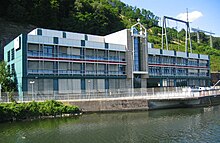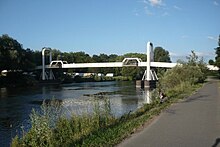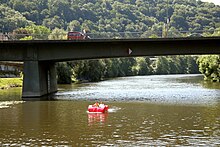List of sights in the Ruhr Valley






The sights on the approximately 221 km long Ruhr are accessible through the route of industrial culture (especially the history and present of the Ruhr ), the Ruhrhöhenweg , the RuhrtalRadweg , but also the Kaiser route . These include, among others, palaces, castles, monasteries, churches, mills, sluices, ferries, viaducts, reservoirs, power plants and collieries. At Hagen , the Lenneroute runs along the Lenne , the most important tributary of the Ruhr, which rises on the Kahler Asten , also near Winterberg .
Like many historical places in North Rhine-Westphalia , some are also linked with legends. Among the historical territories along the Ruhr valley include the Duchy of Westphalia , the county Arnsberg , the County of Mark , the rule of Hardenberg , Reichsstift If that pen food , the rule Broich and the Duchy of Jülich .
In 1851, Johann Georg Kohl described the division of the Ruhr Valley into three sections:
“(...) The course of the Ruhr can then be divided into the following natural sections: 1.) The upper Ruhr valley up to the union at Neheim and up to the mouth of the Möhne ; 2.) the middle Ruhr in a wide valley with several small tributaries to the mouth of the Lenne and to the narrow Thal passage at Herdecke ; 3.) the lower Ruhr from the last narrow point downwards through an always narrow valley and with very insignificant tributaries to the mouth. "
The sights and historical places are sorted from the source of the Ruhr to the mouth. The demarcation is controversial, because the actual Ruhr valley is a natural spatial unit and only includes the valley of the river between Witten - Heven and Mülheim an der Ruhr .
Upper Ruhr Valley
- Niedersfeld
- Wildenberg Castle
- Grimme monument
- Assinghausen
- Bruchhausen Castle
- Bruchhauser stones
- Bike Arena Sauerland
- Olsberg
- Antfeld Castle
- Gevelinghausen Castle
- Eversberg local history museum
- Eversberg Castle
- Hünenburg (Meschede)
- Meschede
- Königsmünster Abbey
- Galilee Monastery
- Laer Castle
- Stesser castle
- Schiedlike Borg at Freienohl
- Gut Bockum (Marienkapelle)
- Wildshausen Castle
- Rumbeck Abbey
- Arnsberg Castle
- Wedinghausen Monastery
- Landsberger Hof
- Rüdenburg
- Herdringen Castle
- Herdringen open-air theater
- Oelinghausen Monastery
Middle Ruhr valley
- Oldenburg Castle
- Fürstenberg Castle
- Neheim
- Höllinghofen Castle
- House fruits
- Good Oevinghausen
- Arnsberg-Menden airfield
- House real houses
- Wild forest Vosswinkel
- Wickede
- Scheda monastery
- Hünenknfer Castle
- Chain forge museum
- Fröndenberg
- Fröndenberg Collegiate Church
- Ardey Castle
- House Schoppe
- Dahlhausen Castle
- House Opherdicke
- House Ruhr (Hengsen)
- House Villigst
- Hohensyburg
- Niedernhof
- Hengsteysee
- Koepchenwerk
- Hengstey run-of-river power plant
- Stiftsmühle power station
- Herdecke
Lower Ruhr Valley
- Freiherr vom Stein Tower
- Herdecke viaduct
- Kaysbergerbank colliery
- Harkortsee
- Cuno power plant
- Werdringen moated castle
- Harkort Tower
- Harkortberg
- Castle weather
- Weather
- Good Schönfeld
- Volmarstein Castle
- Good Schede
- Mallinckrodt House
- Gut Obergedern
- Henriette Davidis Museum
- Berger memorial
- Hohenstein hydropower plant
- Viaduct Witten
- House Witten
- Witten
- Steinhausen Castle
- Nightingale colliery
- Muttental mining trail
- Hardenstein Castle
- Ruhr Valley Railway
- Herbeder lock
- Ruhr Valley ferry
- Herbede
- House Herbede
- Heveney Leisure Center
- Kemnader See , Bochum
- Gibraltar colliery
- House Kemnade
- Stiepeler village church
- Colliery Pfingstblume
- Blankenstein Castle
- Gethmann garden
- Blankenstein lock
- Rauendahl Castle
- Rauendahler sliding path
- Henrichshütte
- House break
- City of Hattingen
- House cliff
- Birschel mill
- Hattingen Jewish cemetery
- Hattingen (Ruhr) station
- Isenburg
- St. Mauritius Cathedral
- Altendorf Castle
- Dahlhauser civil engineering colliery
- Dahlhausen floating bridge
- Dahlhausen lock
- Hasenwinkel coal way
- Bochum-Dahlhausen train station
- Dr. C. Otto & Comp.
- Railway Museum Dahlhausen
- Vryburg
- House Horst , Essen-Horst
- Villa Vogelsang
- Horster Mühle hydroelectric power station
- Well-guarded mine
- Holtey floating bridge
- Holteyer harbor
- Ludwig-Kessing-Park
- Wisthoff glassworks
- Kurt Schumacher Bridge (Essen)
- Food Steele
- Spillenburg lock with lock house
- Schellenberg Castle
- Red mill
- House Heisingen
- Schellenberg hunting lodge
- House Scheppen
- Korte cliff
- Old copper turning station
- Hesper Valley Railway
- Baldeneysee
- Klusenkapelle
- New Isenburg
- Baldeney Castle
- Villa Hill
- Neukirchen lock
- Brehminsel
- Gustav Heinemann Bridge
- Eat-becoming
- St. Lucius Church
- Werden monastery
- Paper mill sluice
- Herrenburg
- Old castle
- Kattenturm
- Oefte Castle
- Kettwig railway bridge
- Kettwig
- Turkish source
- Kettwig Lake
- Landsberg Castle
- Hugenpoet Castle
- St. Lawrence Church
- Ruhr Valley Bridge Mülheim
- Cistercian monastery Saarn
- Ruhrnatur House
- Kahlenberg hydropower plant
- Water station
- Ruhr lock Mülheim
- Broich Castle
- Mülheim an der Ruhr
- Aquarius water museum
- Styrum Castle
- Raffelberg hydropower plant
- Raffelberg brine bath
- Alstaden
- Duisburg Zoo
- Duisburg
- Duisburg-Ruhrort ports
- Duisburg inner harbor
- Ruhrort
See also
- List of flowing waters in the Ruhr river system
- List of Ruhr bridges
- List of dams in the Ruhr
- Lenneroute
literature
- Dirk Sondermann : Ruhr sagas. From Ruhrort to Ruhrkopf . Bottrop: Henselowsky Boschmann Verlag , 2nd edition, September 2005, ISBN 3-922750-60-5
Web links
Individual evidence
- ^ Johann Georg Kohl : The Rhine. Volume 2. 1851, p. 230
- ↑ Handbook of the natural spatial structure of Germany: Sheet 108/109: Düsseldorf / Erkelenz (Karlheinz Paffen, Adolf Schüttler, Heinrich Müller-Miny) 1963; 55 p. And digital version of the corresponding map (PDF; 7.4 MB)

